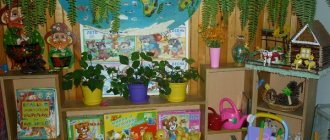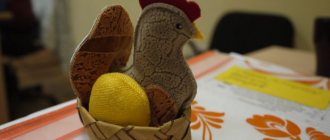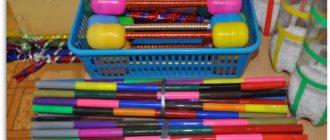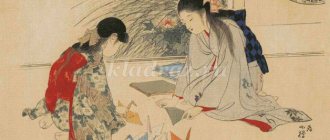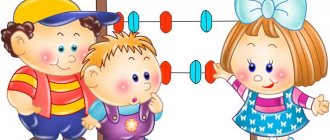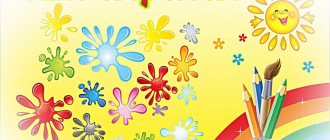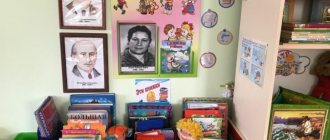Methodological recommendations for educators on the design and organization of a corner for parents in a preschool educational institution
The teacher must behave in such a way that every movement educates him, and must always know what he wants at the moment and what he does not want. If the educator does not know this, whom can he educate?
A. S. Makarenko
This article says that for a child a family is a whole world in which he lives, develops, makes discoveries, learns to love, rejoice, and sympathize. The foundations of a child’s personality are laid in the family; here he receives his first life experience. And with this experience he comes to preschool.
Currently, the crisis of young families is expressed in the aggravation of the difficulties of family education and weakening attention to spiritual values. The lack of a conscious attitude among young parents towards their role, a decrease in social attitudes towards the upbringing and education of children, inconsistency of ideas about the goals, objectives of upbringing, patterns of mental development of the child - all this negatively affects the stability of the young family and the full development of the child’s personality, increases emotional tension in family, negatively affects the development of children. Material values often dominate over spiritual ones, so children’s ideas about kindness, justice, tolerance, and patriotism are distorted. Therefore, we, teachers, need to do a lot of work with parents in order to improve the family’s pedagogical competence, the ability to use a variety of verbal and non-verbal methods of communication with the child.
In accordance with the Law of the Russian Federation “On Education” and the Model Regulations on a Preschool Educational Institution, the priority task of the work of groups of preschool children is “Interaction with the family to ensure the full development of the child.” The problem of interaction between kindergarten and family has always been relevant and difficult.
Relevant - because the participation of parents in the lives of their children helps them see a lot, and difficult - because all parents are different; they, like children, need a special approach. Working with parents, we help them see the difference between the world of children and the world of adults, discover the strengths and weaknesses of the child and take them into account in solving educational problems, show sincere interest in the actions of the child and be ready for emotional support.
One of the most important criteria for assessing the quality of education and part of the subject-developmental environment in a preschool institution implementing a preschool education program, which must correspond to the implementation of all components of education and upbringing of preschool children, meet the requirements of the Federal State Educational Standard for Preschool Education, is the creation by the teacher, together with parents, of an environment for a versatile child development, his successful socialization in society. And therefore, a well-designed parent corner provides the best opportunity to contact the parents of the students. The corner for parents is part of the subject-development environment in the preschool educational institution.
A developmental environment should be understood as a natural, comfortable, cozy environment, rationally organized, rich in a variety of sensory stimuli and play materials. In such an environment, it is possible to simultaneously involve all children and parents of the group in active cognitive and creative activities. The defining moment of creating an environment is the pedagogical idea and goal. Achieving this goal is carried out through the implementation of the chosen educational program.
The problem of transforming the developmental subject environment of a kindergarten in a preschool institution was dealt with by such scientists as Yu. S. Manuylov, S. L. Novoselova, V. A. Petrovsky, N. A. Ryzhova, L. P. Strelkova. Over the years, scientists have accumulated vast experience in understanding the environment as a condition or factor favorable in working with preschool children. L. I. Novikova, N. L. Selivanova, E. N. Stepanov attached importance to the environment as a component of the educational system itself. [4, p.38]
One of the most important corners in the development environment is the corner for parents in kindergarten, which is used to make it convenient and interesting for parents to get acquainted with the life of preschool children who spend most of their time in kindergarten. All information in the corner for parents must be displayed correctly. After all, parental interest in it depends on the correct design, proper placement of information and style. Experience shows that all information that is written or printed in small print remains practically unheeded. Everything needs to be written in an accessible language that will be understandable to parents. It is necessary to avoid pedagogical phrases - this often scares away rather than attracts. Or parents will not pay any attention, and will even ignore the information corners, and with them your work.
With the help of the information displayed in the parent's corner, mothers and fathers and other family members will be able to see the successes of their children, find out what classes are held with their children and other important events in the preschool educational institution, and also read the right tips on how best to raise their kids. Thanks to all the information, parents are more attentive to their children and monitor their progress. Some begin to treat the work of educators with the most respect. Before setting up a corner for parents of newly admitted children, you need to find out how important the information provided by teachers every day is for them, not only through individual communication (consulting), but also through visual information. A survey of parents newly admitted to the group of children, within the framework of a questionnaire proposed to them on the topic: “The importance of the parent’s corner in the upbringing and development of a preschooler,” showed that:
- 36 parents (75%) - do not read and are not informed by the information presented;
- 14 parents (25%) are interested in and apply in their practice the information that is presented to them.
Based on the results of the survey, a consultation was held with parents on the topic “Content of the Corner for Parents,” during which the teacher introduced the parents to the approximate contents of the corner. During a seminar with parents and teachers of a preschool educational institution on the module: “Conditions for transforming the subject-spatial environment, as a factor necessary for the development of preschool children through the implementation of various types of activities,” we came to the conclusion that corners for parents in preschool educational institutions really do everything their functions, and we (teachers) are advised to follow the following simple rules:
− Select short articles that can provide complete information and make parents want to continue communication with the teacher on this topic;
− You cannot use terms that are incomprehensible to parents;
− It is necessary to place information at parental eye level;
− Use a font size of at least 14 in printed materials;
− Supplement articles with colorful drawings by preschoolers, photographs or bright pictures;
− In a tight folder with files you need to place all the information about the preschool educational institution, consultations of all specialists, as well as useful articles from magazines and newspapers;
− The information that will be posted on the stand for parents should be important. The material should be updated once every two weeks;
− Any printed material at the stand (be it: advice from a doctor, psychologist, speech therapist) must contain a link to the publication, including authorship and year of publication, the name of the site is also required;
− The stand for the parents' corner should be colorfully decorated (it is better if this is done by a professional artist). When decorating a stand, you should use not only inscriptions, but also photographs of the children of the group or even parents. When decorating stands, there is no need to use large quantities of decorative elements with images of nesting dolls or toys. The mandatory ratio of text and illustrations on stands and information media should be approximately 2:6 (2 parts - text, 6 - illustrations), the main task of which is, first of all, to attract the attention of parents, and only then to “deliver” the necessary information to them .
The corner for parents in the preschool educational institution contains a tablet about the age characteristics of the children in the group. Throughout the year, all material must be updated, including requirements for the physical, mental, moral, labor, aesthetic education of children, as well as the characteristics of their speech development and self-care skills. It is necessary to indicate what children should learn by the middle and by the end of the year.
After the seminar, some of the parents began to work closely with us and even offered their sketches of corners for parents. Thanks to this, our group has wonderful bright and beautiful stands with the following sections:
Section “Our life day by day,” which presents materials about the past day in the form of drawings, crafts, lyrics of songs learned in music classes or a walk, the name of a piece of music listened to, a book read to children. The material must be updated daily. In this section there may be such appeals: “Mom, learn with me a tongue twister: “There is grass in the yard, there is firewood on the grass, there are children on the firewood””; “Dad, tell me a riddle: “There’s a pear hanging - can’t you eat it?”
Section "Children's Rights" for parents. Includes a variety of information on the observance of children's rights in preschool institutions and families; it may also contain addresses and telephone numbers of organizations in your city where you can turn for help, and official documents.
Section “For you, parents” , which presents data on the height and weight of children in this group, routine moments of the day, a monthly plan for working with parents and a schedule of continuous educational activities in this group.
The “Menu” section is filled out without abbreviations, indicating the product output in clear handwriting.
Section "Advice from Experts". A physical education worker can give a complex of gymnastics or advice on hardening, a music director can give a repertoire of classes, a list of works for listening. If the preschool educational institution employs such specialists, a speech therapist, a teacher of additional education in a foreign language and choreography, then there must be a section where all the information about these classes is placed. A teacher-psychologist or a nurse can prepare materials for mobile folders, which have a permanent section in the corner for parents.
Section “Bulletin Board” , which contains only official information: when and where there will be a parent meeting, performance or other important events that may occur at the preschool educational institution.
Based on the results of the final survey of parents conducted at the end of the school year, the following conclusion can be drawn: parents began to show interest in the life of the group, began to participate in the life of the group, and learned to express admiration for the children’s activities.
Diagram based on the results of the survey
Conclusion: The success of the educational process in a preschool institution directly depends on the degree of coordination between teachers and parents. In this connection, the exchange of information and experience, the search for interesting ways to organize work with children, as well as awareness of the results of the educational activities of preschoolers are very important. All these aspects of cooperation are reflected in the corner for parents. And the teacher’s task is to methodically competently and aesthetically design this corner in his group.
A. S. Makarenko said: “Do not think that you are raising a child only when you talk to him, or teach him, or order him. You nurture it in every moment of your life. The child sees or feels the slightest changes in tone, all the turns of your thoughts reach him in invisible ways, you do not notice them” [8, p. 152].
Literature:
- Doronova T. N. Interaction of a preschool institution with parents: A manual for preschool workers. educational institutions. - M., 2012
- Dron A. V., Danilyuk O. L. Interaction of preschool educational institutions with parents of preschool children. Saint Petersburg. Detstvo-Press, 2012. “Preschool educational institution management” No. 5/2010.
- Magazine “Handbook of senior preschool teachers” No. 8/2008.
- Artamonova O. Subject-spatial environment: its role in personality development // Preschool education. - No. 4. - 2007.
- Zvereva O. L., Krotova T. V. Communication between a teacher and parents in a preschool educational institution: a methodological aspect. M.: Creative Center, 2005.
- Mikleeva N.V. Kindergarten and young family: Fundamentals of successful interaction. M.: Creative Center, 2010.
- Osipova L. E. “Work of a kindergarten with a family” - 2008.
- Magazine “Child in Kindergarten” No. 3 (2006) Dorokhina N. “School for caring parents.”
- Makarenko, A. S. A book for parents: lectures on raising children / A. S. Makarenko. - M.: Pravda, 1985.
Folders - moving “Autumn” for preschoolers: contents of folders
Each of the three folders contains the following pages:
- What does a child of this age know about autumn? What to tell him about.
- Pictures about autumn to look at with your child.
- Educational autumn games and experiments.
- Poems about autumn to read to children and memorize.
Each page has a landscape sheet format - A4 (vertical).
The material in each folder is designed taking into account the age of the children and all methodological requirements for familiarizing preschoolers with the world around them.
All sheets of folders are colorful and bright, realistic and are designed so that the pictures can be viewed with a child while discussing autumn phenomena in nature.
We tried very hard to create a special mood in each folder and look at autumn through the eyes of a child! And also bring joyful mood and smiles to all of you - our readers! Therefore, the folders turned out to be very bright and kind, very sunny and bringing you our warmth!
The authors of the “Autumn” folders are: I, Asya Valasina, Candidate of Pedagogical Sciences in the field of preschool pedagogy, practical teacher, author of this site “Native Path”. And designer Anna Novoyarchikova.
All materials in the book folders can be transferred to friends, colleagues, acquaintances, downloaded and printed, and used in kindergartens, centers, and families. We, the creators of these folders, will be glad if our work is in demand and needed by people, and as many people as possible use it! Therefore, we make these folders free for distribution and you can get them without any payments or subscriptions.
Folder - moving "Autumn": for parents of children 3-4 years old
Below in the folder description are examples of pictures in a compressed format. You can download the same pictures in full size and good resolution for free above in this article in the section “Download moving folders “Autumn”
The moving folder about autumn for children of primary preschool age includes the following sheets:
- Title,
— What does a 3-4 year old child know about autumn?
— Poems about autumn for children 3-4 years old: I. Bunin “Autumn”, K. Balmont “Autumn”, A. Koltsov “The winds are blowing”, M. Khodyakova “If the leaves on the trees turned yellow”, E. Trutneva “It suddenly became twice as bright”, A. Teslenko “Autumn”, A. Pleshcheev “Boring picture”, L. Razvodova “The rain of mischievous leaves swirled above me.”
— Educational games on an autumn walk with a 3-4 year old child: “Which branch are the children from?”, “Casts from nature”, “Drawing a herbarium from leaf prints”, “Find the same one”, “Developing the eye. Swing for a leaf", "Introducing a child to trees", "Leaf prints with colored pencils", "Riddle game: autumn trees"
— Autumn mathematics on a walk with a child: “How are they similar?”, “What is more?”, “Continue the pattern.”
— For little reasons: why is the hare white in winter and gray in summer? Experiment for children.
— Signs of autumn: pictures with the task for the child “Find the signs of autumn.” While discussing the top picture with your child, ask him why this is not summer? After all, it also rains in summer. Pay attention to the girl's warm clothes. If she dressed warmly, that means...? (it’s cold outside, but warm in summer). In the bottom picture, find signs of autumn (the harvest is ripe, the leaves are falling).
